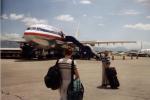In 1998, I traveled to Haïti with my father and sister.
We were traveling with a group active with
World Vision, an inter-denominational
Christian relief organization. Our trip was involved with the establishment
of micro-enterprise development projects in the country.
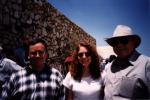 |
Me, my sister, and my father at the airport in Port-au-Prince,
Haïti, after getting through customs.
|
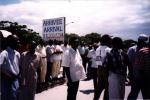 |
Lots of activity outside of the airport when we arrived. This was the
last week of May, and the outside temperature was over 90°F.
Nevertheless, everyone wears longs pants, and many were even wearing
blue jeans.
|
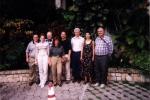 |
This was our group. From left to right: me, my sister, my dad, Ann,
Buz, Steve, Cindy, and Bill. Buz was our leader.
|
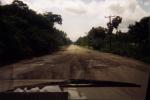 |
There is one major highway through the southern half of Haïti.
In the 1980's, it was reportedly in great shape, and the drive from
Port-au-Prince to Les Cayes could be done in under three hours. Since
then, no maintenance whatsoever has been performed, and the drive takes
over five hours. Here, the pavement has completely disappeared for
about 10 meters. You will notice that we were driving on the left.
In Haïti, one drives on the side of the road that has disintegrated
the least. As Bob Shacochis wrote in The Immaculate Invasion,
"Nowhere in the world had I traveled a surfaced road in greater
disrepair, its bed so severely exposed that the pavement appeared to be
the victim of low-altitude cluster bombing."
|
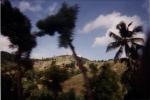 |
A view of a hillside by the road, taken while driving. Haïti
should be a tropical rain forest. Much of the landscape is deforested,
in some cases by over 90%. The problem got worse during the trade
embargo imposed by the United States during the Cédras regime
in the early 1990's eliminated supplies of imported petro-fuels used
for cooking. The need for fuel forced many to cut down trees throughout
the country.
|
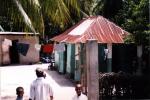 |
This looked like many of the homes in the Haïtian countryside.
Most are one-room structures made of cement block with metal roofing,
often painted in bright tropical colors. I'm not sure what the
smaller structure to the left is.
|
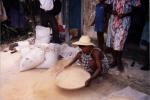 |
This woman was a recipient of a World Vision Micro-Enterprise loan.
She buys rice in bulk from local farmers, sifts it, and repackages it
for sale to consumers in the local market. The vast majority of loan
recipients are women.
|
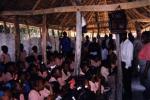 |
This was an elementary school. It is a single large, open room. The
structure was made entirely of local materials. Different grades
congregated in different corners of the building. Being on top of a
hill, and being a partially open structure, it was actually well
ventilated and reasonably cool.
|
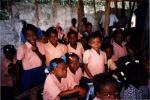 |
A class of either first or second grade girls. There are no chairs
and desks in this school, just benches and skinny rails to lean
notebooks against.
|
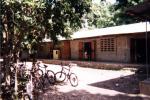 |
This was another elementary school. It was constructed of cement
blocks with a metal roof. Each grade met in a separate room. It was
much hotter inside this school, and without electricity, it was dark
as well.
|
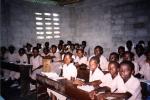 |
This was the inside of the elementary school. It was pretty dim lighting
and very hot. There were over 30 children in this small room. From
what I could tell, much of the instruction was drills of repeating things
out loud over and over, although that may have been a show for our
benefit.
|
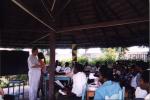 |
My dad, speaking through an interpreter to several of the recent
loan recipients. Several members of our group gave brief talks.
My dad spoke about product differentiation as an essential part of a
successful business strategy.
|
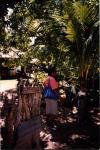 |
This was one of the local World Vision workers who went with us
most places. She spoke excellent English and had a great understanding
of the micro-enterprise program's vision and execution.
|
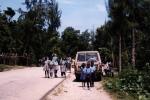 |
Our vehicle, surrounded by children. They all wear uniforms to go to
school, and I think our presence was an excuse for a field trip of
sorts.
|
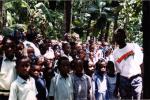 |
This was a group of school children we met. The village had built
an experimental garden where the community was trying to grow
different varieties of vegetables as cash crops. Several of these
children helped out in the project. This was one of the projects
that was generally regarded as successful.
|
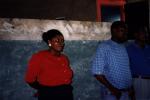 |
Two of the World Vision national staff from Port-au-Prince, giving a
short talk to the local World Vision staff before we all ate lunch.
|
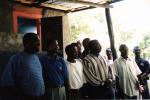 |
These were mostly local staff members at this particular Area
Development Program center.
|
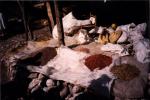 |
This was an example of some of the produce available at a local market
in a small town in the Southern Province. This particular market met
once a week, and almost all of the food was sold unpackaged, as you
see here.
|
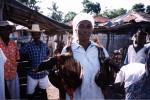 |
This was a woman who had received a World Vision Micro-Enterprise loan
to raise turkeys.
|
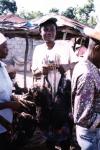 |
This was another woman who had also received a World Vision loan to
raise poultry for sale in the market.
|
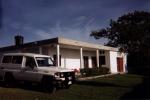 |
While in the Les Cayes area, we stayed at a guest house operated
by a Baptist Mission. It was on top of one of the taller hills
surrounding the town, and while not air conditioned, it was much
cooler than the town.
|
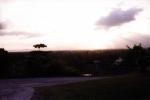 |
A view of the sunset from our guest house near Les Cayes in
the South Province.
|
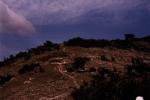 |
This is a road our 4x4 made it over in the deforested hills above Les
Cayes. The vast majority of the roads in Haïti, paved or not,
require four wheel drive vehicles. This hill should be completely
covered in tropical rain-forest.
|
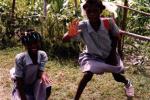 |
These two girls followed us as we walked around. They were on their
way home from school.
|
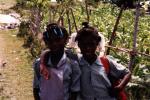 |
The field behind them was planted with corn. A different corn field
that we walked through one afternoon had stalks much higher than my
head.
|
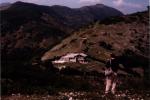 |
The cement block building in this photo was being built (by hand) by
the local community, with the leadership of World Vision local staff.
It was intended to be a future World Vision office and guest house.
The location was in the hills above where a new port facility and
major road improvements were planned.
|
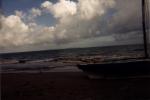 |
We spent about an hour at the beach near Les Cayes, one of the
best beaches in the country.
|
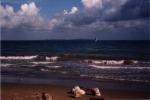 |
The island in the distance is Île à Vache. This was
facing south.
|
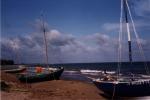 |
Some fishing boats. When we first looked at them, they seemed to be
of dubious sea-worthiness. We were assured by the locals, though, that
fishermen go out in these all the time.
|
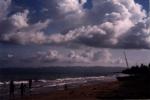 |
This is facing west, looking at the row of hills on the end of
Haïti's southern peninsula.
|
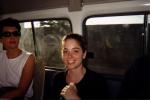 |
My sister, as we drove through Port-au-Prince. Our main transport was a
Toyota Land Cruiser that belonged to the World Vision Haïti
national staff. It was purchased used, and had previously been an
ambulance, so we all sat on benches facing each other.
|
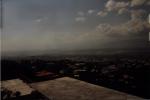 |
This is a view of the city from the
Hotel
Montana veranda. Port-au-Prince is one of the oldest cities in
the western hemisphere. Because of political circumstances, the city's
infrastructure has decayed tremendously. None of the street lights
work, electric power is highly erratic, water and sewage are problematic,
and the streets and buildings frequently look as if they've been bombed.
|
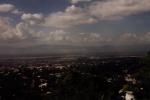 |
Another view of Port-au-Prince. The city is very flat. Very few
buildings are more than three or four stories tall. The city is also
home to nearly half of the country's population, so it has become very
dense. We heard that in some of the poorer slums, the population
density is so high that people have to take turns sleeping for lack of
floor space.
|
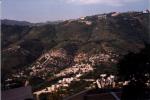 |
Another hillside in Port-au-Prince. You can clearly see how the land
that isn't part of an immediate neighborhood has been picked clean of
any trees. Deforestation is at an extreme level in central
Haïti.
|
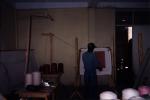 |
This was a factory in Port-au-Prince that made latch-hook rugs for
an art store in Arizona. It was designed as a pilot project that could
be replicated as a cottage industry throughout the country. For several
reasons, it was unfortunately not succeeding.
|
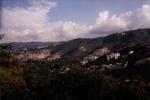 |
This is the valley that connects Port-au-Prince with the wealthy
suburb of Pétionville. It was by far the most heavily wooded
part of Haïti that I saw. It also had some very large private
homes, including the $2 million home of former Catholic priest, former
President Jean-Bertrand Aristide.
|
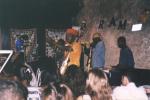 |
This was a band we saw perform at the Hotel Olofsson, called RAM. The
leader of the band is an American expatriate who moved to Port-au-Prince,
married a local woman, and started the band. During the Cédras
regime, their performances were one of the few instances of peaceful
interracial social interaction anywhere in the country.
|
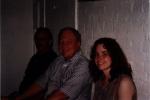 |
My dad and sister in the hotel, listening to the music. RAM's music
is a modern interpretation of classic voodoo songs.
|
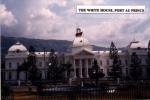 |
This is the "White House" in Port-au-Prince, where the country's
president lives.
|












